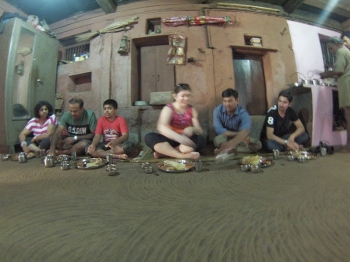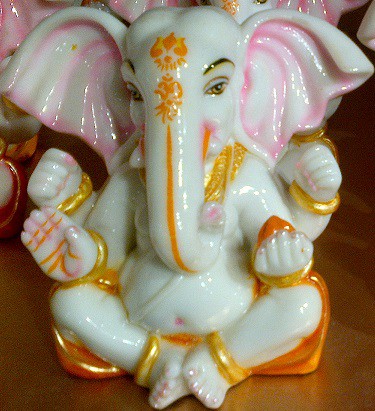11/14/2014
Why in India people eat sitting on the floor?
“This tradition is not just about sitting on floor and eating, it is regarding sitting in the ‘Sukhasan’ position and then eating. Sukhasan is the position we normally use for Yoga asanas (i.e. yoga positions). When you sit on the floor, you usually sit cross legged – In sukhasana or a half padmasana (half lotus), which are poses that instantly bring a sense of calm and help in digestion, it is believed to automatically trigger the signals to your brain to prepare the stomach for digestion.”
NB: It was brought to my attention that the above message answers the question of the lotus position but not the eating-on-the-ground. In my opinion, 1. It is easier to sit in the lotus position on the ground than on a chair, 2. Indians usually living numerous in a small place, it is more practical not to have a table (it takes less space and anyways when you eat with your fingers you don't really need a table: you can hold your plate with one hand and bring it to mouth level (if required) and use the other hand to grab food), 3. You feel less hot on the floor. It is just my opinion though...
Source: 20 Amazing Scientific Reasons Behind Hindu Tradition: http://desinema.com/hindu-traditions-scientific-reasons/
08:00 Posted in Why in India... | Permalink | Comments (0) | Tags: india, why, tradition, food, eating on the floor | ![]() Facebook | |
Facebook | |
10/10/2013
Why in India people eat with their fingers?
This post is dedicated to one of my French bosses who asked me recently, after a trip in India, if in my opinion “they” would continue to eat with their hands for a long time. “These savages” he might as well have added.
Before I praise the practice of using fingers, a small memo on how the “sophisticated” countries actually stopped it...
“The use of fork dates back to ancient times. The Egyptians already used some kinds of metal hooks for cooking and grabbing food in the pots.
The forks we use today are believed to have appeared in the Byzantine Empire. They were introduced in North Italy in the middle of the eleventh century where they were originally reserved for pasta. 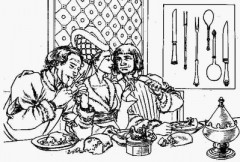
The fork was presented in France by Catherine de Medici but its use first remained very restricted (to cooked pears). Her son, Henri III, during a trip to Italy in 1574 got seduced by this funny tool which enabled people to eat without staining the huge collars or “strawberries”, that were so fashionable. Thus he returned in France with forks and showed it off at his favourite restaurant: Hostellerie de Tour D'Argent (current Tour D'Argent in Paris).
The use of this tool emerged very gradually in France. At the table of Louis XIV, each guest had a fork on the left of their plate, but it was not used because the King himself preferred to eat with his fingers...
It is only at the end of the seventeenth century that the fork was finally used to bring food from the plate to the mouth. It is at the same time that the shape changed, from two to four prongs.”*
So it has been only 400 small years that we stopped eating with our fingers in France!
And I find kind of sad! I think eating with fingers has only advantages. First the food tastes better – it must be the combination of four senses instead of three.
It is more eco-friendly (so much we won’t wash!).
You don’t burn your tongue – but your fingers.
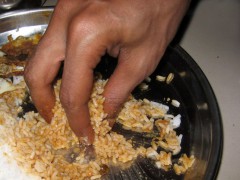 And you don’t get snapped at because you don’t use your fork or knife properly. Well, you may get a comment if you get food up to the palm: according to ‘good manners’** in northern India, where commonly people use bread (chapati) to gather the food, food should not cross the second phalange. In such situation, just reply that you learned to eat in South India where a rules are less strict (instead of chapatis they eat a lot of rice which is not so easy to grab! (But don’t overdo it or youey’ll give the impression to be a pig!)
And you don’t get snapped at because you don’t use your fork or knife properly. Well, you may get a comment if you get food up to the palm: according to ‘good manners’** in northern India, where commonly people use bread (chapati) to gather the food, food should not cross the second phalange. In such situation, just reply that you learned to eat in South India where a rules are less strict (instead of chapatis they eat a lot of rice which is not so easy to grab! (But don’t overdo it or youey’ll give the impression to be a pig!)
The only important thing is to avoid using the left hand. That would be gross! When you think it is the hand dedicated to ass-wiping...
What is funny is that the majority of tourists in India (my mother ahead of the pack) are really disturbed when they have to eat with their hands... And yet don’t we eat French fries and chicken legs with fingers in France?
* Source: http://www.indax.com/eating.htm
08:03 Posted in Why in India... | Permalink | Comments (0) | Tags: india, eating with hands, eating with fingers, hands, fingers, eat, good manners, chapati, roti, rice, fork, history of the fork, food | ![]() Facebook | |
Facebook | |
10/08/2013
Why in India fat guys have the paunch of a pregnant woman?
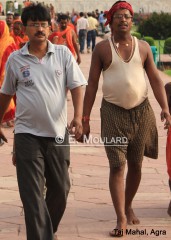 I've always wondered whether it was only in my head or the belly of paunchy Indians had a special shape. To put it simply, they look like pregnant women. It also happens to quite a few Indian women past their fifties (which makes me wonder every time I meet one “isn’t she too old to be pregnant?”).
I've always wondered whether it was only in my head or the belly of paunchy Indians had a special shape. To put it simply, they look like pregnant women. It also happens to quite a few Indian women past their fifties (which makes me wonder every time I meet one “isn’t she too old to be pregnant?”).
With a little research I found out that it is not only in India that overweight men are more apple-shaped than pear-shaped (a female prerogative)!
Some people are more prone to accumulate visceral fat that grows deep in the abdomen and around the organs which gives the belly the apple shape. And others retain subcutaneous fat (under the skin) which often settles in the lower part of the body, including the hips and legs. (1)
And that would be genetic: it is not the same genes that are most active in abdominal fat and thigh fat, and the location of these genes depends on the solicitation of hormones during development. (2)
From there, it is quite possible that Indian males have a particular genetic issue, as they already have a genetic predisposition to have hairs in the ears (cf post). A certain Dr. Patel also claims that “in the United States, the accumulation of fat occurs in the whole body but in India it is centered around the belly”. (3)
But other factors can play in the advent of the appled Indian...
 I thought for a moment about Zola and his Nana who was so beautiful because she was fat and fair skinned. Where a fat tummy would be a (ostentatious) sign of wealth of the man who got away from manual chores. But even poor guys often have a big paunch here (when they are not super skinny).
I thought for a moment about Zola and his Nana who was so beautiful because she was fat and fair skinned. Where a fat tummy would be a (ostentatious) sign of wealth of the man who got away from manual chores. But even poor guys often have a big paunch here (when they are not super skinny).
In India, it's too hot to work out! Indians are not sportive – 9 gold medals in 21 participations at the Olympics (4), it gives the tone! And don’t get me started with cricket... First many players are far from having the bodies of soccer players (see the picture of Dwayne Leverock, who did not hesitate to throw his 120 kilos to catch the ball during the 2007 World Cup (one of the only games I've watched and an action I will never forget!)). (5) Secondly most of the (adult) cricket fans prefer to play cricket German-style: watching it on TV!
I agree yoga was born in India. But on one hand yoga is more about feeling well in your body than getting an hourglass figure (you can just look at my yoga teacher if you need proof) and on the other hand yoga became popular in India only quite recently – after it became fashionable in the West actually! (6)
That being said, people are more and more aware of problems related to overweight, such as diabetes that affects more than 40 million Indians – here again they seem to have a local genetic predisposition for this disease (7). Hence an explosion of the number of gyms in lately: from almost none when I arrived in 2006 to thousands today. But well, only 0.23 million Indians are believed to have a gym membership... (8) So we can safely say that Indians are culturally anti-sportive!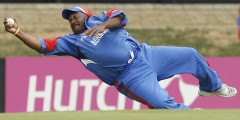
And there is food... Traditionally Indian food is rich in carbohydrates (rice, wheat) and fats (a curry is not a curry if it is not full of butter or ghee). And on top of this Indians are fond of snacking.
And last but not least, I think that Indians do not find a big paunch unaesthetic. The dream of my ex-favourite Indian when he was a kid was to have a big tummy like his dad!
Just have a look at Ganesh and his belly (human but elephantine size!)…
Or the regular comments I get on my weight (here).
(1) http://perdreduventre.net/deux-types-de-graisse-abdominale-quel-est-le-pire/
(3) http://articles.timesofindia.indiatimes.com/2013-09-08/ahmedabad/41872756_1_diabetes-centre-dr-mayur-patel-nirma-university; http://www.Hindu.com/Seta/2006/05/04/stories/2006050400121500.html
(4) http://en.wikipedia.org/wiki/India_at_the_Olympics
(5) http://www.criticaltwenties.in/sport/xi-best-performances-in-the-cricket-world-cup-by-fat-cricketers
(6) http://indiatoday.intoday.in/story/The+fitness+rage/1/85334.html
(7) http://healthcare.financialexpress.com/200808/diabetes02.shtml;
http://diabetes.diabetesjournals.org/content/62/5/1369; http://www.ncbi.NLM.NIH.gov/PubMed/17496355; http://articles.timesofindia.Indiatimes.com/2013-09-08/Ah...
(8) http://articles.economictimes.indiatimes.com/2009-08-14/news/27657062_1_vikram-aditya-bhatia-talwalkars-gold-s-gym
Source picture: http://travel.CNN.com/Mumbai/life/potbelly-138381
Other source: http://www.FAO.org/AG/AGN/nutrition/ind_en.stm
08:00 Posted in Why in India... | Permalink | Comments (0) | Tags: india, big paunch, big tummy, big belly, fat, pregnant women, overweight, obesity, sport, gym, food, ganesh, genetics, hair in the ears, abdominal fat, apple shape, pear shape, yoga, diabetes, dwayne leverock, cricket, weight | ![]() Facebook | |
Facebook | |















